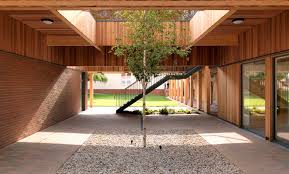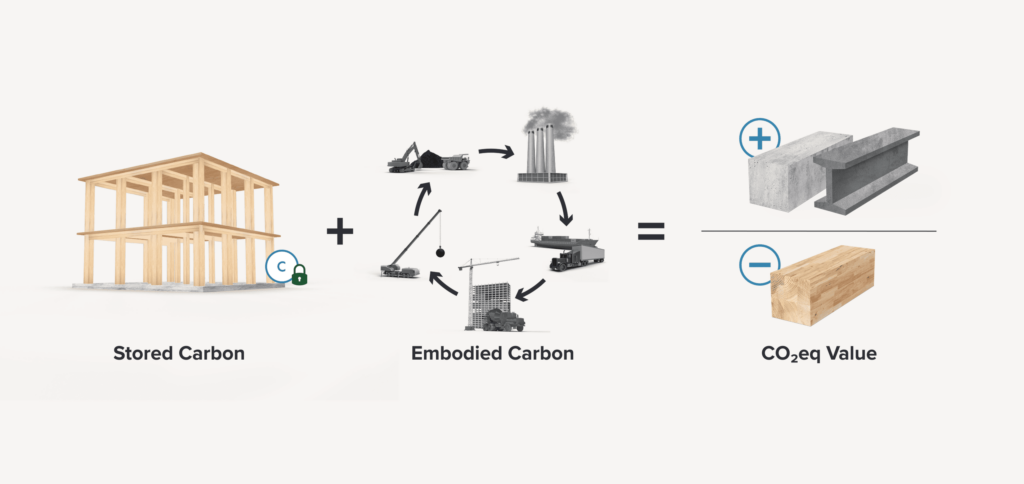
Wood-integrated Architecture: Inventive Uses, Designs and the Future
Wood comes across as one of the most primal building materials used by humans and has been an integral part of architectural design for centuries. In recent years, wood has seen a revival in popularity, driven by technological advancements and an increasing focus on sustainability. This blog will explore the innovative uses and contemporary designs of wood in architecture, highlighting how architects are redefining traditional applications and crafting breathtaking structures that seamlessly merge nature with innovation.
Role of Wood in Net-zero Energy Buildings
Research consistently highlights the significant benefits that wood offers in reducing the carbon footprints of buildings, making it an ideal material for net-zero energy construction. Unlike traditional building materials like concrete and steel, wood is a renewable resource that naturally sequesters carbon, effectively removing it from the atmosphere and storing it within the structure of the building. According to Think Wood, “cities built from bio-based materials like timber can help turn cities from carbon emitters into carbon sinks,” demonstrating the potential of wood to contribute to urban sustainability and climate change mitigation.

Additionally, the energy required to produce wood is substantially lower than that for other common structural materials. Manufacturing lumber is the least energy-intensive process compared to other top materials used in construction, such as concrete, virgin steel, and even 100% recycled steel. This lower energy demand reduces the overall embodied energy of buildings, which refers to the total energy required to produce, transport, and assemble building materials. By choosing wood over concrete and steel for commercial and residential buildings, greenhouse gas emissions can be reduced by an average of over 60%, significantly lowering the environmental impact of construction.
Furthermore, wood’s versatility and adaptability in design also support energy efficiency in buildings. Wood’s natural insulating properties help maintain indoor temperatures, reducing the need for artificial heating and cooling, which is a major contributor to a building’s operational energy use. This not only enhances the building’s energy performance but also contributes to the overall goal of achieving net-zero energy, where the total amount of energy used by the building is roughly equal to the amount of renewable energy created on-site. As building technologies and design strategies continue to evolve, wood will play an increasingly vital role in developing sustainable, net-zero energy buildings that are both efficient and environmentally friendly.
Biophilic Design

Similar to reducing buildings’ carbon footprints, wood is also a fundamental aspect of biophilic design – a new architectural trend that aligns our innate need to connect nature with modern, built environments. Timber plays a significant role in achieving biophilic design, as its tactile qualities immediately evoke a sense of nature, even in urban settings. Research shows that incorporating timber elements in buildings can reduce stress and anxiety, lower blood pressure and heart rates, and promote positive social interactions. Additionally, wood’s excellent acoustic properties can help prevent echoes and reduce noise pollution, both inside and outside, enhancing the overall auditory comfort and well-being of the building’s occupants.
To learn in depth about biophilic design, do not hesitate to read my article on it after this one: https://archinspires.com/2023/07/15/the-rise-of-biophilic-design-how-it-is-reshaping-urban-architecture/!
Organic Forms and Curved Structures

Wood’s natural flexibility and malleability have long made it an ideal choice for creating organic forms and curved structures in architecture. From the sweeping elegance of arches to the fluid motion of undulating roofs, wood allows architects to explore bold and innovative designs that push the boundaries of traditional construction materials. The development and integration of advanced technologies, such as computer-aided design (CAD) and computer numerical control (CNC) machinery, have further expanded the potential for crafting intricate wooden geometries and forms. These tools enable architects to realise complex and imaginative shapes with a high degree of precision and efficiency. Examples such as the wooden pavilion at the 2015 Expo Milano and the Tamedia Office Building in Switzerland illustrate how wood can be moulded into captivating, dynamic structures that evoke a sense of harmony and tranquillity within the built environment. By combining the natural warmth of wood with modern technology, architects can create spaces that feel both innovative and deeply connected to the natural world.
Innovative Wooden Skyscrapers

One of the most groundbreaking developments in wood architecture today is the rise of timber skyscrapers. Traditionally, the construction of tall buildings relied heavily on steel and concrete due to their strength and durability. However, recent engineering advancements have paved the way for timber to become a practical and sustainable alternative for high-rise construction. Timber skyscrapers offer several significant advantages over conventional materials, including reduced carbon footprints, faster assembly times, and enhanced thermal insulation properties. These benefits are particularly appealing in an era that increasingly values sustainability and environmental responsibility. Notable projects such as Mjøstårnet in Norway, which is currently the world’s tallest timber building, and the Brock Commons Tallwood House in Canada, showcase the innovative application of materials like cross-laminated timber (CLT) and glulam beams. These examples demonstrate that timber, when properly engineered, can provide the necessary strength, stability, and fire resistance required for modern high-rise buildings. As these pioneering structures continue to prove the capabilities of timber, they inspire a rethinking of the potential for wood in urban architecture, opening up new possibilities for sustainable and aesthetically compelling design.
The Future of Wood

Ultimately, wood continues to captivate architects and designers with its natural beauty, sustainability, and versatility, transforming the architectural landscape and challenging our perceptions of such structures. From timber skyscrapers and organic forms to hybrid constructions and adaptive reuse projects, wood has become a preferred material for crafting stunning, environmentally responsible buildings. With advancements in digital design tools and materials science enhancing wood’s properties, such as strength and fire resistance, the potential for innovative uses of wood in architecture is expanding rapidly. As we strive for more sustainable building practices, wood’s renewable nature and carbon-sequestering capabilities make it a key material in the future of architecture, enabling the creation of spaces that blend seamlessly with the natural world while meeting modern design challenges.
Sources
- Team, NORclad. “Why Do Architects Use Wood? | NORclad.” NORclad | Timber Cladding Solutions, 7 Aug. 2021, www.timbercladdingsolutions.co.uk/why-do-architects-use-wood/.
- Think Wood. “Net Zero Buildings – Does Wood Store Carbon?” Think Wood, www.thinkwood.com/sustainable-architecture-design/net-zero-carbon-buildings#:~:text=does%20that%20work%3F-.
- “Wood in Architecture: Innovative Uses and Modern Designs.” Exotic Wood Zone , 2024, exoticwoodzone.com/blogs/e/wood-in-architecture-innovative-uses-and-modern-designs?srsltid=AfmBOoqUsNKptNqKBwuhZS42iMYB0vx7fqaavuebEJkCJ-k-CWMIo5pe.



